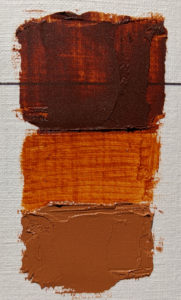
Prehistoric cave painters made pigment in much the same way, without the aid of a DeWalt cordless drill for stirring though. Construction sites often scrape off the topsoil, which is organic matter we’re not interested in, to reveal wonderful colors. You’re likely to see reds, oranges, and yellows – all forms of iron oxide, along with other minerals that change the color or color strength.
If you’re gathering rocks, bring a hammer or use a harder rock to break rocks open so you can see the color inside. It’s often not the same on the inside at all! You can also scrape the rock on a hard surface to see what comes off. You may think you have a beautiful green rock, for it only to be a thin layer of moss. The rock may look red but the color may be a dusting of iron oxide from nearby clay. The color will look different when wet too.
In the pictures below, I’ve gathered a red clay from a construction site. I pulled out the twigs and gravel, and ground it in a granite mortar and pestle. Then I sieved through a kitchen colander and three wire screens, progressively finer. That rough sandy pigment was then mixed into water, allowed to settle, pouring off the water and any scum several times. Then stirred again, waiting a few seconds for heavier particles to settle. The top being poured off and passed through a 300 mesh screen to be dried on filter paper. The thin dried cakes break apart easily with a mortar and pestle, or you could use a rock tumbler with some porcelain balls like you’d use for weighting pie crusts during baking.

mass tone/undertone/tint
